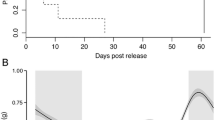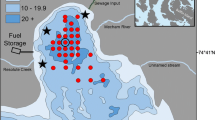Abstract
We monitored swimming speed of 2–3 year-old juvenile Atlantic cod (Gadus morhua) from August to December 1999, using a 2-D location finding acoustic telemetry system in a coastal area of Newfoundland, Canada. We concurrently monitored the locations of 22–41 individuals by triangulation using a fixed hydrophone array. We estimated average swimming speeds at intervals of 60–120 s and compared them over a 1 to 17 °C thermal range, three diel periods, and five substrates (sand, gravel, sand-sparse boulder, boulder, and kelp). However, cod did not exhibit a change in swimming speed over the temperature range studied. Increased activity and foraging rates (expressed as swimming speeds) were expected to increase at elevated temperatures due to increased metabolic demands. Activity did vary significantly with diel cycle and substrate. Swimming speeds were significantly lower at night during September and October. Results for August and November were inconclusive, while swimming speed was significantly lower during the day in December. We observed significantly reduced average swimming speeds in structurally complex substrates (e.g. rock, cobble and kelp) in September and October. Our results suggest that activity of juvenile cod in the wild does not vary with temperature as predicted from studies in the laboratory. Instead, activity varied with diel cycles and structural complexity, variables that influence an individual's ability to forage and seek refuge, potentially altering individual fitness.
Similar content being viewed by others
References
Bagge, O. & J. Bay, 1987. Periodicity of feeding in Baltic Cod. ICES 1987/J:8.
Bogstad, B., G. R. Lilly, S. Mehl & O. K. Palsson, 1994. Cannibal-ism and year-class strength in Atlantic cod (Gadus morhua L.) in Arcto-boreal ecosystems (Barents Sea, Iceland, and eastern Newfoundland. ICES Mar. Sci. Symp. 198: 576-599. 127
Bradbury, C., J. M. Green & M. Bruce-Lockhart, 1995. Home ranges of female cunner, Tautogolabrus adspersus (Labridae), as determined by ultrasonic telemetry. Can. J. Zool. 73: 1268-1279.
Brown, J. A., P. Pepin, D. A. Methven & D. C. Somerton, 1989. The feeding, growth, and behaviour of juvenile cod, Gadus morhua L., in cold environments. J. Fish Biol. 35: 373-380.
Clark, D. S. &J. M. Green, 1990. Activity and movement patterns of juvenile Atlantic cod, Gadus morhua, in Conception Bay, New-foundland, as determined by sonic telemetry. Can. J. Zool. 68: 1434-1442.
Confer, J. L., G. L. Howick, M.H. Corzette, S.L. Framer, S. Fits-gibbon & R. Landesberg, 1978. Visual predation by planktivores. Oikos 31: 27-37.
Cossins, A. R. & K. Bowler, 1987. Temperature Biology of Anim-als. Chapman and Hall, London: 339 pp.
Cote, D., D. A. Scruton, L. Cole & R. S. McKinley, 1999. Swim-ming performance and growth rates of juvenile Atlantic cod intraperitoneally implanted with dummy acoustic transmitters. N. Am. J. Fish. Man. 19: 1137-1141.
Foster, J. J., C. M. Campbell & G. C. W. Sabin, 1993. The effects of temperature acclimation on organ/tissue mass and cytochrome c oxidase activity in juvenile cod (Gadus morhua). J. Fish Biol. 42: 947-957.
Goddard, S. V., M. H. Kao & G. L. Fletcher, 1992. Antifreeze pro-duction, freeze resistance, and overwintering of juvenile Atlantic cod (Gadus morhua). Can. J. Fish. aquat. Sci. 49: 516-522.
Gotceitas, V. & J. A. Brown, 1993. Substrate selection by ju-venile Atlantic cod (Gadus morhua); effects of predation risk. Oecologia 93: 346-351.
Gotceitas, V. & P. Colgan, 1989. Predator foraging success and habitat complexity: quantitative test of the threshold hypothesis. Oecolgia 80: 158-166.
Gotceitas, V., S. Fraser & J. A. Brown, 1995. Habitat use by juven-ile Atlantic cod (Gadus morhua) in the presence of an actively foraging and non-foraging predator. Mar. Biol. 123: 421-430.
Gotceitas, V., S. Fraser & J. A. Brown, 1997. Use of eelgrass beds (Zostera marina) by juvenile Atlantic cod (Gadus morhua). Can. J. Fish. aquat. Sci. 54: 1306-1319.
Gregory, R. S. & J. T. Anderson, 1997. Substrate selection and use of protective cover by juvenile Atlantic cod Gadus morhua in inshore waters of Newfoundland. Mar. Ecol. Prog. Ser. 146: 9-20.
Gregory, R. S., D. A. Methven, L. A. Wheeler, D. C. Schneider & J. A. Brown, 2000. Relative strength of the 1999 year-class from the nearshore surveys of demersal age 0 Atlantic cod in 3KL and in Newman Sound, Bonavista Bay. Can. Stock Assess. Sec. Res. Doc. 2000/094.
Hawkins, A. D., N. M. Soofiani & G. Smith, 1985. Growth and feeding of juvenile cod (Gadus morhua L.). J. Cons. Perm. Int. Explor. Mer. 42: 11-32.
Helfman, G. S., 1993. Fish behaviour by day, night and twilight. In Pitcher, T. J. (ed), Behaviour of Teleost Fishes, 2nd edn. Chapman and Hall, New York (NY): 479-512.
Krohn, M., S. Reidy & S. Kerr, 1997. Bioenergetic analysis of the effects of temperature and prey availability on growth and con-dition of northern cod (Gadus morhua). Can. J. Fish. aquat. Sci. 54 (Suppl. 1): 113-121.
Lawson, J. W., J. T. Anderson, E. L. Dalley & G. B. Stenson, 1998. Selective foraging by harp seals Phoca groenlandica in nearshore and offshore waters of Newfoundland, 1993 and 1994. Mar. Ecol. Prog. Ser. 163: 1-10.
Leonard, J. B., J. F. Norieka, B. Kynard & S. D. McCormick, 1999. Metabolic rates in an anadromous clupeid, the American shad (Alosa sapidissima). J. Comp. Physiol. 169: 287-295.
Linehan, J. E., R. S. Gregory & D. C. Schneider, 2001. Preda-tion risk of age-0 cod (Gadus) relative to depth and substrate in coastal waters. J. exp. mar. Biol. Ecol. 263: 25-44.
Løkkeborg, S., 1998. Feeding behaviour of cod, Gadus morhua: activity rhythm and chemically mediated food search. Anim. Behav. 56: 371-378.
Løkkeborg, S., A. Bjordal & A. Fernö, 1989. Responses of cod (Gadus morhua) and Haddock (Melanogrammus aeglefinus)to baited hooks in the natural environment. Can. J. Fish. aquat. Sci. 46: 1478-1483.
Løkkeborg, S. & A. Fernö, 1999. Diel pattern and food search be-haviour in cod, Gadus morhua. Envir. Biol. Fishes 54: 345-353.
Lough, R. G., P. C. Valentine, D. C. Potter, P. J. Auditore, G. R. Bolz, J. D. Neilson & R. I. Perry, 1989. Ecology and distribution of juvenile cod and haddock in relation to sediment type and bottom currents on eastern Georges Bank. Mar. Ecol. Prog. Ser. 56: 1-12.
Mattson, S., 1990. Food and feeding habits of fish species over a soft sublittoral bottom in the Northeast Atlantic. 1. Cod (Gadus morhua L.) (Gadidae). Sarsia 75: 247-260.
Müller, K., 1978. Locomotor activity of fish and environmental os-cillations. In Thorpe, J. E. (ed.), Rhythmic Activity of Fishes. Academic Press, New York (NY): 1-19.
Ryer, C. H. & B. L. Olla, 1997. Altered search speed and growth: social versus independent foraging in two pelagic juvenile fishes. Mar. Ecol. Prog. Ser. 153: 273-281.
Sarno, B., C. W. Glass & G. W. Smith, 1994. Differences in diet and behaviour of sympatric saithe and pollack in a Scottish sea loch. J. Fish. Biol. 45 (Suppl. A): 1-11.
Savino, J. F. & R. A. Stein, 1982. Predator-prey interactions between largemouth bass and bluegills as influenced by simu-lated submersed vegetation. Trans. am. Fish. Soc. 111: 255-266.
Sayer, M. D. J. & J. Davenport, 1996. Hypometabolism in tor-pid goldshinny wrasse subjected to rapid reductions in seawater temperature. J. Fish Biol. 49: 64-75.
Scott, W. B. & M. G. Scott, 1988. Atlantic fishes of Canada. Can. Bull. Fish. aquat. Sci. 219.
Sogard, S. M. &B. L. Olla, 1998. Contrasting behavioural responses to cold temperatures by two marine fish species during their pelagic juvenile interval. Envir. Biol. Fishes 53: 405-412.
Staaks, G., F. Kirschbaum & P. Williot, 1999. Experimental studies on thermal behaviour and diurnal activity rhythms of juvenile European sturgeons (Acipenser sturio). J. appl. Ichthyol. 15: 243-247.
Systat, 1997. Systat 7.0 Statistics. Chicago, IL: 759 pp.
Utne, A. C. W., 1997. The effect of turbidity and illumination on the reaction distance and search time of the marine planktivore Gobiusculus flavescens. J. Fish Biol. 50: 926-938.
Werner, E. E. & J. F. Gilliam, 1984. The ontogenetic niche and spe-cies interactions in size-structured populations. Ann. Rev. Ecol. Syst. 15: 393-425.
Winger, P. W., P. He & S. J. Walsh, 2000. Factors affecting the swimming endurance and catchability of Atlantic cod (Gadus morhua). Can. J. Fish. aquat. Sci. 57:1200-1207.
Author information
Authors and Affiliations
Rights and permissions
About this article
Cite this article
Cote, D., Ollerhead, L., Gregory, R. et al. Activity patterns of juvenile Atlantic cod (Gadus morhua) in Buckley Cove, Newfoundland. Hydrobiologia 483, 121–127 (2002). https://doi.org/10.1023/A:1021367225993
Issue Date:
DOI: https://doi.org/10.1023/A:1021367225993




